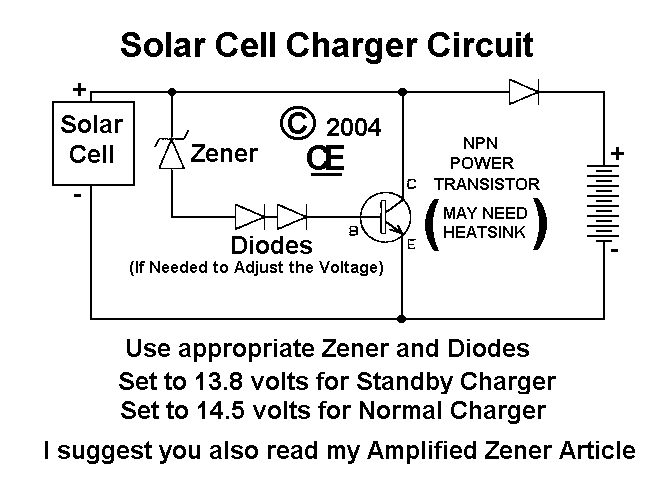But it is Definately a good idea for some applications and I thought I would make
it available to those persons not familiar with this method of Voltage Regulation.
One application is where you need a Higher Power Zener, Possibly even a 100 watt rating.
Another useful application is as a Shunt Regulator for Solar Cells that are used
to charge "Lead Acid Batteries". Simply Place it in parallel with the Solar Cell
and use Diode De-coupling between it and the battery.
A 13 volt Zener diode will work well for charging a 12 volt battery on Standby
use. Or use a 14 volt zener a diode for a Standard 14.6 volt charge.
The Output voltage of this Amplified Zener is the "Zener Voltage" PLUS the
"Emitter to Base Voltage" (Typically about .6 volts)
Therefore a 14 volt zener will result in a 14.6 volt Amplified Zener.
Adding a 1N4005 or a 1N4148 diode in series with the zener will increase the voltage by
about 0.6 volts. A 1N5819 Schotkey diode will increase the voltage by about 0.3 volts.
While most NPN Power Transistors will work, Higher Gain Transistors will give
a much tighter "Knee Voltage". (better voltage Stability than any zener by itself)
CX is Optional. It greatly reduces noise, but in a simple solar cell charging circuit,
it isn't needed. The Capacitance effect of "CX" is also GREATLY Amplified by the
transistor. In Operation the Zener in this circuit will typically only dissipate about 75 mW,
so any 250 mW (or greater) zener is acceptable.
NOTE: Zener Diodes are usually available in tolerances of 5%, 10% and 20%.
A 12 volt Zener, with a 20% tolerance can be anything between 9.6 volts to 14.4 volts.
That is a Huge Variation and can Greatly affect your results.

